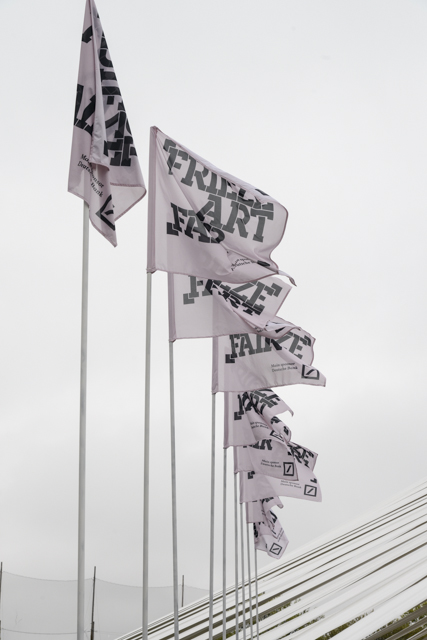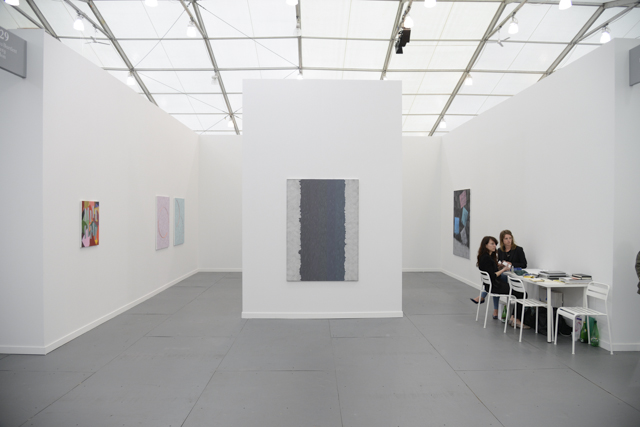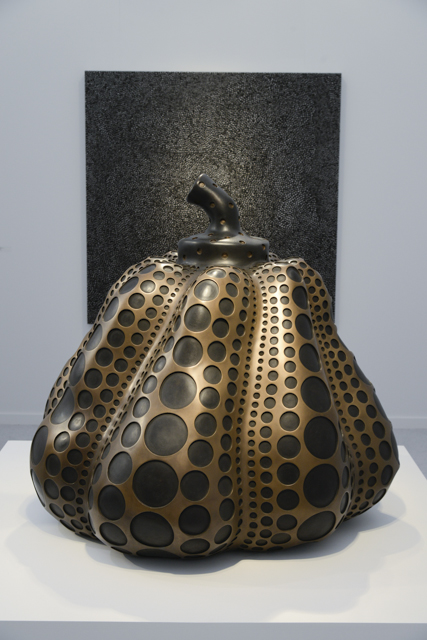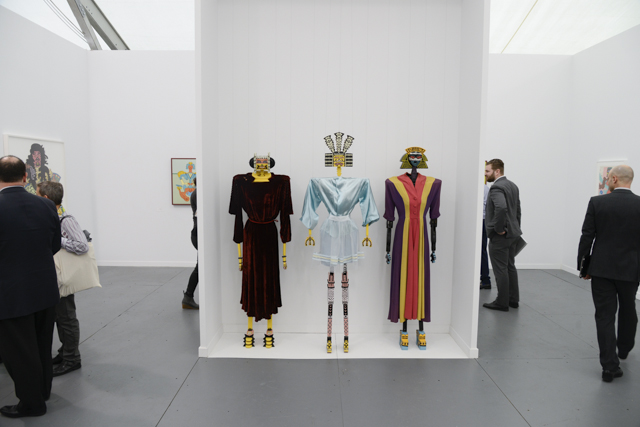
Frieze New York. All photographs Christian Grattan.
Frieze may have always been just another fair, but after three years of existence in New York, its novelty may have finally worn off. Even before arriving to Randall’s Island, the site of the Frieze Art fair, we overheard a collector complaining while we waited for the ferry: “The same old art, by the same old artists, at the same old fairs.”
That complaint turned out to be eerily accurate, even if there were fewer examples of artists who had work for sale at multiple galleries. For one thing, after the third year, the fair begins to resemble a grocery store; every brand has its aisle. Where’s David Kordansky Gallery? The same place he always is: the front north entrance. Massimo De Carlo has been across from Kordansky for three years too. There were seemingly countless other examples like this; Gavin Brown, Hauser & Wirth, and Ramiken Crucible—they are all more or less where they were last year. I wasn’t sure how I felt about this, but it seemed like a good sales strategy. Collectors will be able to navigate the fair more easily. When I mentioned it to David Kordansky Gallery’s Stuart Krimko he simply responded, “It’s like the Honda Accord. They switch it up every once and a while.”
Presumably they do this because people need to believe they’re buying something new, and improved. Whether that’s required at an art fair remains to be seen, but sales seemed to going well for the blue-chip galleries despite a more subdued atmosphere this year. James Cohan and Laura Bartlett both reported sold-out booths, while many others were content to simply say they were doing “fine” or very “good.” “It’s calmer than in years past,” an art handler who wished to remain anonymous told us, “and more subdued.”

Alex Olson at Laura Bartlett Gallery. Photo: Christian Grattan
What that means, of course, is always a guess. “You never know [how sales are going] because people lie,” Jonathan T.D. Neil, director of the Sotheby’s Institute of Art told us. According to Neil, knowing who’s selling and who’s not is important to understanding the larger ecosystem of the gallery world. “A New York-based blue-chip gallery may have sold out, but some lesser-known gallery from Berlin might not have sold a thing,” he said. That wasn’t just a random example; it’s harder for out of town galleries with fewer connections to do well at these fairs. We overheard one Chicago gallerist mention that Frieze is great because “there’s people from Europe.”
Hoping to get a better sense of what external factors might be influencing this year’s calmer tone, I asked Neil whether the soft Modernist and Impressionist auctions at Christie’s and Sotheby’s could impact the sales at the fair. He seemed skeptical. “[In 2011] you’ll see the Modern sale didn’t do well, but a week later the Contemporary sale did,” he explained. “It just showed that the Contemporary market is its own force. I don’t see anything that’s fundamentally changed since then.”
What has changed over the course of the three years we’ve been visiting Frieze is the quality of the art being shown. For all the Instagrams and slideshows made of this fair, there’s precious little to think or talk about this year. Mostly, it’s work we’re used to seeing; Yayoi Kusama’s dot sculptures and paintings, Erwin Wurm’s bloated sculptures (this year, a dancing peanut), and Anish Kapoor’s untitled wall dishes.

Yayoi Kusama. Photo: Christian Grattan
“Nothing’s stood out yet,” artist Trong Nyugen told us, after having completed seeing nearly all of the fair. Those words were a lot nicer than anything we had to say. Not only was it boring, but after spending a couple of hours at Frieze, you end up thinking that the only reason anyone makes art is to sell it. That’s not representative of what’s going on in the art world as a whole, but after seeing rows upon rows of material-based practices with little to no content, it’s hard to think of art as having any other purpose than to decorate your home.
Why there’s so much sameness permeating Frieze is anyone’s guess, but some dealers and gallerists appear to be growing tired of the format. Hauser & Wirth put together On the Fabric of the Human Body, a curated show of four artists organized by independent Curator Gianni Jetzer that included work by artists Rita Ackermann, Louise Bourgeois, Isa Genzken, and Paul McCarthy. “We do so many fairs. It’s refreshing,” we overheard a staff member tell a collector at the Hauser & Wirth booth.
Hauser & Wirth was one of a handful of galleries trying to stand out, if not with their work then through display. Marianne Goodman’s booth had no walls, just a desk situated underneath a Danh Vo suspended from the tent’s rafters. Anton Kern, Victoria Miro, and Artists Space were just a few of the galleries that brought carpeting or built-out rooms to distinguish their booths from the typical white-walled and white-floored cube. Derek Eller Gallery brought a fantastic solo booth of Chicago art-scene pioneer Karl Wirsum; the centerpiece being a built-out display for costumed mannequins in Wirsum’s signature robotic, comic-book style. When asked about his selection of Wirsum, Derek Eller mentioned, “It probably sticks out like a sore thumb…It’s not process-based abstraction.”
That seemed to be a tacit admission that the art at the fair wasn’t particularly great. Naturally, though, most dealers did not welcome conversations about the subpar quality of the work. P.P.O.W. co-founder Penny Pilkington simply reminded us that “There are pools of good art around.” There always are, but ideally, a fair won’t have you hunting for them.



{ 2 comments }
you had me at wall dishes. (you could have had me at hole-punch pumpkins.)
i’m pretty sure that’s a dancing wiener sculpture. I thought you guys were really into wieners so this mistake is a little surprising!
Comments on this entry are closed.